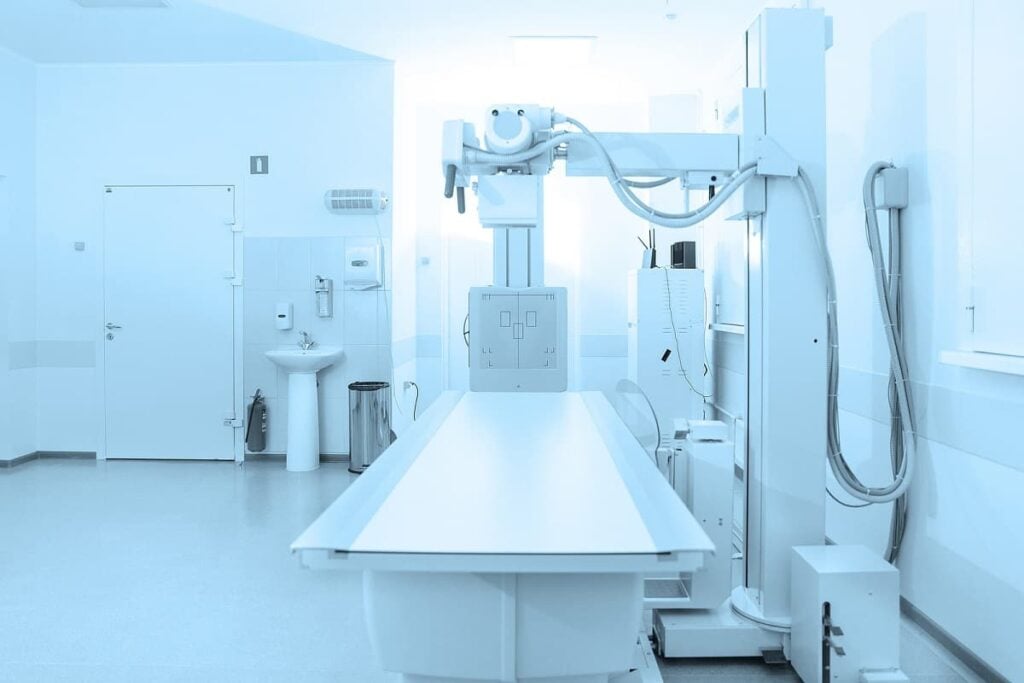Relay Therapeutics Stock: Pure Play on AI Drug Discovery
Table of contents

A few years ago, we wrote an article about how computational chemistry is merging with artificial intelligence technologies to speed up drug discovery. Computational chemistry is a scientific field that uses computer simulations to help solve chemical problems. A related field is computational biology, which uses similar techniques to answer complex questions about biology. Add in machine learning algorithms, and scientists can now largely automate the process of identifying druggable disease targets and potential therapies before doing the more laborious and costly work of synthesizing small molecule drugs and conducting clinical trials.
We’ve written quite a bit about AI healthcare and the many companies using AI for drug discovery. More recently, we’ve focused on four AI drug discovery stocks available to investors, and liked the business model of one company enough that we added it to our Nanalyze Disruptive Tech Portfolio. Somehow we missed a fifth AI drug discovery company that went public through a traditional IPO in July 2020 called Relay Therapeutics (RLAY). While we briefly profiled Relay Therapeutics in 2019 in our piece on computational technologies and drug discovery, it’s time to take a deep dive and see if we picked the right company for our portfolio.
About Relay Therapeutics Stock
Relay was founded in 2016 by four scientists, including Dr. David E. Shaw, a billionaire former hedge fund manager who pioneered the use of algorithms for securities trading. Today, Dr. Shaw holds a couple of different appointments at Columbia University and is also chief scientist of D.E. Shaw Research, which uses specially built supercomputers for drug discovery.

The rest of the team are hardly slackers themselves. Dr. Dorothee Kern is a professor of biochemistry at Brandeis University who also co-founded MOMA Therapeutics, another Cambridge, Massachusetts company focused on drug discovery using many of the same techniques as Relay Therapeutics. Dr. Matthew Jacobson is also an academic and entrepreneur whose company Global Blood Therapeutics (GBT) is reportedly the target of a $5 billion acquisition by Pfizer for its sickle cell therapeutics. Jacobson also sits on the board of Schrödinger (SDGR), a computational chemistry company that leans heavily on machine learning for developing drugs. It also went public in 2020. Last but certainly not least is Dr. Mark Murcko out of MIT who has helped shepherd nine drugs to market, including two for the treatment of HIV while at Vertex Pharmaceuticals (VRTX), a biotech worth more than $70 billion.
Some equally quality names are attached to Relay’s investor list, including Google’s venture capital arm and the SoftBank Vision Fund. D.E. Shaw Research is both an investor and partner (more on that shortly). Altogether, the company had raised $520 million as a startup before an upsized IPO in July 2020 netted the company about $425 million. Last year, Relay issued a secondary offering of stock at a price of $26.50 and hauled in another $382 million and change. Today, the company sits on a market cap of $2.15 billion with Relay Therapeutics stock trading close to its original IPO price of $20 from two years ago. That’s despite the fact that the company has yet to bring a drug to market or realize significant revenue outside of one big pharma deal (also more on that shortly).
Relay Therapeutics Platform
All of this begs the question: What is the Relay Therapeutics platform and how does it work? Most drug development is focused on proteins, the molecular machines behind most biological processes. Conventional approaches rely on analyzing static images of protein fragments to provide insights on druggable targets. In contrast, Relay Therapeutics studies the three-dimensional motion of proteins using genomic data, computational biology, and machine learning. The company has termed and trademarked the approach as Motion-Based Drug Design, which it claims results in medicines with greater specificity and potency by analyzing the way proteins change shape and how a particular shape influences disease.
The platform itself is called Dynamo, also trademarked. It employs new experimental techniques such as cryo-electron microscopy, or Cryo-EM, which won the 2017 Nobel prize in chemistry by revealing high-resolution information about the structure of biomolecules. Combined with techniques like molecular dynamics and machine learning, Dynamo can reputedly speed up the drug discovery process.

The process breaks down into three key phases:
- Develop a mechanistic understanding of the dynamic behavior of a target protein and identify areas where a small molecule drug could potentially have an effect.
- Dynamo then identifies chemical starting points through a system of experimental and virtual screens, rapidly developing and prioritizing possibly drug candidates.
- Machine learning models do what they do best: repeat and rinse, so the process continuously improves the understanding of protein motion.
In April 2021, Relay reinforced its platform with the $85 million acquisition of ZebiAI Therapeutics, a biotech that applies massive experimental DNA-encoded library datasets to power machine learning for drug discovery.
Relay Therapeutics Pipeline and Partnerships
So far, Relay has churned out three lead product candidates, all focused on cancer and all in early clinical stages of testing. Its most advanced drug, dubbed RLY-4008, targets a protein called FGFR2 that is often mutated in cancers. RLY-2608 is going after breast cancer. And RLY-1971 is being developed to inhibit a type of metastatic tumor in collaboration with Genentech, a venerable biotech firm that became a subsidiary of Roche back in 2009 for nearly $47 billion. The Genentech deal represents the only revenue that Relay has generated to date – about $95 million in upfront and milestone payments.

As we noted earlier, co-founder Shaw’s computational biochemistry research firm is a key collaborator. Relay relies on the firm’s Anton 2 supercomputer, as well as its proprietary algorithms and software, for computational modeling capabilities focused on analyzing protein motion. In other words, D.E. Shaw Research provides key technologies that make Dynamo dynamic.
Should You Buy Relay Therapeutics Stock?
We recently profiled another AI drug discovery company, Exscientia (EXAI), which has a much more robust pipeline and portfolio of partnerships than Relay Therapeutics. But we wouldn’t invest in Exscientia because of its inconsistent revenues. In addition, its drug discovery platform remains unproven until the company can successfully bring a drug to market – a prospect that is years away from fruition. The same concerns apply to Relay Therapeutics stock. Moreover, Relay has only one major pharma deal versus at least three for Exscientia. We’re also concerned about the company’s reliance on Shaw’s research firm for key parts of its platform. Big-name scientists also have big egos, and Relay wouldn’t be the first company hobbled by infighting among its founders, each of whom has plenty of distractions with their other businesses and jobs.
Relay Therapeutics had about $838 million in its war chest, which the company claims is enough to keep the lights on into at least 2025. There’s no way any of its current drug candidates will be marketable by then. Where will the additional money come from to reach the finish line? Well, the Genentech deal is potentially worth up to $695 million if Relay opts to forego the profit/cost share model, but that’s a lot of milestones to trigger. Perhaps it can attract more customers to pay to use its platform, similar to Exscientia. The more likely scenario is yet another public offering that might dilute shareholder value. Relay Therapeutics stock is already 55% off of its high in 2020, compared to a 25% return on the Invesco QQQ Trust (QQQ), a popular exchange-traded fund (ETF) that tracks the Nasdaq-100 Index. The way things are looking now, we can expect more of the same well into the future.
Conclusion
AI drug discovery is one of the most exciting technologies today, illustrating the game-changing potential for machine-learning algorithms to help us stave off disease and live longer. But there’s a huge gap between potential and profit. Even the best of the bunch, Schrödinger, is struggling to grow revenues despite using a sort of hybrid software-as-a–service (SaaS) business model where customers license its drug discovery capabilities on an annual basis.
We’d like to see Relay Therapeutics and the rest of the AI drug discovery companies figure out a way to establish more consistent revenue streams. They may be developing new therapies in nontraditional ways, but they’re still relying on staid business models that have seen many a biotech flame out over time.
Sign up to our newsletter to get more of our great research delivered straight to your inbox!
Nanalyze Weekly includes useful insights written by our team of underpaid MBAs, research on new disruptive technology stocks flying under the radar, and summaries of our recent research. Always 100% free.
















Yahoo article: “Artificial Intelligence (AI) in Drug Discovery Market worth $4.0 billion by 2027 – Exclusive Report by MarketsandMarkets”
Prominent players in this Artificial Intelligence in Drug Discovery Market are NVIDIA Corporation (US), Microsoft Corporation (US), Google (US), Exscientia (UK), Schrödinger (US), Atomwise, Inc. (US), BenevolentAI (UK), NuMedii (US), BERG LLC (US), Cloud Pharmaceuticals (US), Insilico Medicine (US), Cyclica (Canada), Deep Genomics (Canada), IBM (US), BIOAGE (US), Valo Health (US), Envisagenics (US), twoXAR (US), Owkin, Inc. (US), XtalPi (US), Verge Genomics (US), Biovista (US), Evaxion Biotech (Denmark), Iktos (France), Standigm (South Korea), and BenchSci (Canada).
Those reports can be rough 😉 Some new names in there for sure, thank you for posting!
EVGN (Evogene) which was a spin out from CGEN (Compugen) has an interesting business model in both the AG and the Pharma areas. As a nano cap speculation, with some real partners, it might prove of interest to some.
Thank you for the comment Ronald! We wouldn’t even consider touching something that small (under $50 million market cap). Firms that are so miniscule represent far too much risk than we’re willing to take. Choosing not to invest in firms less than $1 billion market cap may be one of the best rules in our methodology and has proved immensely valuable in helping us avoid landmines. There’s a reason most institutional investors have a market cap cutoff.
To anyone reading this, never invest a single cent in AI drug discovery. To translate AI drug discovery into simple terms: companies that want to bamboozle venture capitalists out of inordinate check sizes. Look at the best healthcare dedicated or biotech dedicated investment funds out there over the last 10-15 years – none of them have touched AI drug discovery. The approach taken by smart biotech investment funds: give a company a small seed round ($15-25mn), see some preclinical data, impressive preclinical data, give them a bigger Series A round (3-4x seed size), see more preclinical data, impressive data continues, give them a Series B (1.0-2x Series B size), see some Phase 1 data, preclinical data looks like it’s translating well to actual human data, go public, be a hot IPO, be stagnant until Phase 2 data, data holds up and stock goes up 3x or data proves to not hold up in a bigger patient population and stock drops 90%. Core thesis for the biotech dedicated guys is let’s invest in a sizeable end market disease ($1bn+ market size), go after a market that isn’t saturated with competition (especially not big pharma as competition), go after a protein target that is validated by past success (approved drugs or some prior clinical success), and bet on this drug being super potent to enable good efficacy and little to no safety concerns. Also, let’s stick to small molecules and antibodies, no one needs to burn cash on gene editing, gene therapy, cell therapy, RNA therapy, bifunctional degraders, or mRNA (which we all took and barely works!) until those fields are built out with tons of success and an infrastructure that can support them (both in terms of doctors acceptance and manufacturing capacity and cold chain logistics). The AI drug discovery approach is let’s avoid the dedicated biotech investors who we can’t outsmart and who won’t give us enormous sums of capital right away. Let’s instead go straight to the larger check size but relatively idiotic healthcare investors like Ballie Gifford, Tiger Global, Cathie Wood, Softbank, Mubadala, and pick-your-favorite happy go lucky tech billionaire, and we’ll just raise $250mn seed round from them before we have any data at all, then go back to them a year later and ask for another $250mn without having provided any data still, and then ask them to help fund a $500mn IPO the year after, still with no data. Those guys manage enough capital that they can go to sleep at night comfortable knowing that they invested in “AI” without knowing what that really means or how much investor capital they just lit on fire. There’s a bunch of “AI” drug discovery companies out there, one of them will prove me wrong maybe – Relay’s data in FGFR was very impressive but don’t assume they’ve found the holy grail to drug discovery from that one success. Also, Schrodinger is not AI drug discovery, there is no AI component to it – rather it is the only company out there that enables users to conduct highly precise structure based drug design, and by the way their technology enabled in part Relay’s recent success, so for anyone looking for read-through from that data SDGR deserves some, though they won’t directly benefit financially. This is not a firm recommendation for SDGR either – their path forward requires success as a drug development company and investors will need good clinical data out of their clinical pipeline to be rewarded, so 2023/2024 are big years for that story, and software sales will not save the day here. To any retail investor that ever considers a biotech stock – never overpay and never chase. When you see successful clinical data come out or when you see a hot IPO, you will lose money chasing those things – the investors are positioned to be selling on those days and not buying. For IPOs the investors have gotten in at 1/3 the price in the private markets, so wait until the stock is below IPO price to get an entry point into a company that also has a promising drug. When clinical data has come out, the investors have nearly always positioned themselves for it, so when you see it open up 50-100%, the trade is over and you are the bagholder by chasing. So wait until you see it top out, then fall by 30-40% until thinking about entering the stock, and even at that make sure the data is indisputably positive (is the efficacy profile clinically meaningful and competitive, is the safety profile tolerable and approvable, is the end market saturated or massive enough to accommodate multiple players, is the company going to need to raise capital to which the answer is always yes and the act or raising capital is a clearing event to let you know what a good entry price is and whether investors support the company). Ideally, don’t try playing catalysts unless you’re a scientist or doctor with some edge in that particular field of medicine (and even then be extremely cautious). For your own sanity, never buy a preclinical company. And don’t invest until the company has reported Phase 1 data. As far as valuation, get a Seeking Alpha, go on the Earnings Estimates tab for a stock, look at the revenue estimate in 2030 or beyond, that is often the current peak sales estimate of the drug according to consensus, apply 2.5x to that, discount that number by 0.3x for Phase 1, 0.55x for Phase 2, and 0.75x for Phase 3, and then divide that number by 1.4 before even thinking about being attracted to the valuation. So a company is going to have $1bn in 2030? First of all make sure that is backed up by the clinical data you have access to so far, then 2.5x = $2.5bn, then assume Phase 1 so 0.3x=$750mn, then divide by 1.4=about $500mn is the maximum valuation you should willing to even start a position. Other things to keep in mind are the fully diluted share count (be wary of warrants, prefunded warrants, convertible debt, and other sleazy ways these investors and companies try to make a stock appear cheaper than it is). Also keep in mind the patent life of a drug, and specifically the composition of matter patent – if the drug has less than 7-8 years of patent life after the drug is approved, then don’t invest. So, if the drug is in Phase 1 starting today, will be approved probably around 2030, and has a patent for composition of matter that expires in 2037/2038 or later then you are gucci. If it expires earlier then it is a no go. If the drug is in Phase 3 and looks amazing and will be approved in 2024, but composition of matter expires in 2028, don’t touch it. Due your diligence in this space and don’t chase anything. Also don’t bottom fish on a company down 90% when a drug fails, the company will become a penny stock and you will lose everything. More true than any other space in the stock market, you are competing against biology and chemistry geniuses who want you to make a mistake, so don’t give them the satisfaction. As for setting yourself up with a watchlist of potentially interesting ones to be on the lookout for, find where the best biotech funds (RA Capital, BVF, FMR/Fidelity, Orbimed) are putting their money to work, and wait for good entry points like I mentioned. Don’t assume everything these guys touch will work either (their success rate is probably 40-50% but that’s great for them since the winners go up 3-4x for them). Any trade or investment you place on a single stock in this space should make up no more than 1% of your portfolio. In this space, and every other, diligence is king.
This was a phenomenal post and it’s worth reading every word. Thank you very much for taking the time to articulate your thoughts. It’s clear that you have the subject matter expertise to navigate this space and even then it’s still very risky. Really liked the way you work backwards and apply discounts through each phase. Drug discovery in general is far too risky for our tastes but we’ve been following the AI drug discovery space closely nonetheless and are only long one name – SDGR – which as you pointed out isn’t AI (the company also emailed us to say the same). Hadn’t even noticed what you pointed out around who is investing in the more popular AI drug discovery names and how easy large rounds have been to raise.
For anyone looking at investing in this space, take the time to read Jacob’s comment here. It’s very insightful, and we’ll take notice of the things you’ve pointed out when doing further research in this area. Thanks again Jacob.